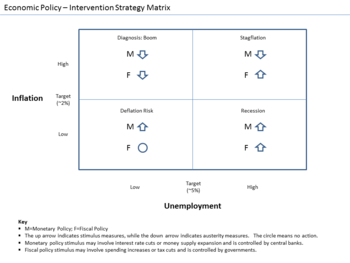
Back Икономически стимул Bulgarian Stimulus (economics) English Talouselvytys Finnish Politique de relance French Stimulus (ekonomi) ID Stimulansåtgärd Swedish Економічне стимулювання Ukrainian منبہ (معاشیات) Urdu 经济刺激 Chinese

In economia, lo stimolo (stimulus) si riferisce ai tentativi di utilizzare la politica monetaria o fiscale (o politiche di stabilizzazione in generale) per stimolare l'economia. Lo stimolo può anche riferirsi a politiche monetarie come l'abbassamento dei tassi di interesse e l'allentamento quantitativo.[1]
Uno stimolo viene talvolta chiamato colloquialmente "innesco della pompa" o "innesco della pompa",[2][Perché 2 volte uguale? Inoltre la fonte è in inglese, la traduzione italiana è un uso attestato?] Negli anni '30, il presidente Herbert Hoover fu accusato di "innesco della pompa",[3] e il presidente Franklin D. Roosevelt usò il termine con connotazione positiva.[4]
- ^ Economic Stimulus, su Investopedia.
- ^ Pump Priming, su Investopedia.
- ^ Steven Horwitz, Herbert Hoover: Father of the New Deal (PDF), su Cato Institute, 29 September 2011, p. 5.«"Hoover and his secretary of the treasury, Andrew Mellon (himself often wrongly portrayed as a defender of laissez faire), proposed $400 million in new federal buildings as well as $175 million in public works through the federal Shipping Board. These proposals met with approval from the professoriate as examples of 'constructive industrial statesmanship.' They were also ridiculed as 'pump priming' in a New York Tribune editorial cartoon of April 8, 1930..."»
- ^ Walter Russel Mead, Signs of the Times: Deflation Ahead, su Mother Jones, April 1998.
© MMXXIII Rich X Search. We shall prevail. All rights reserved. Rich X Search